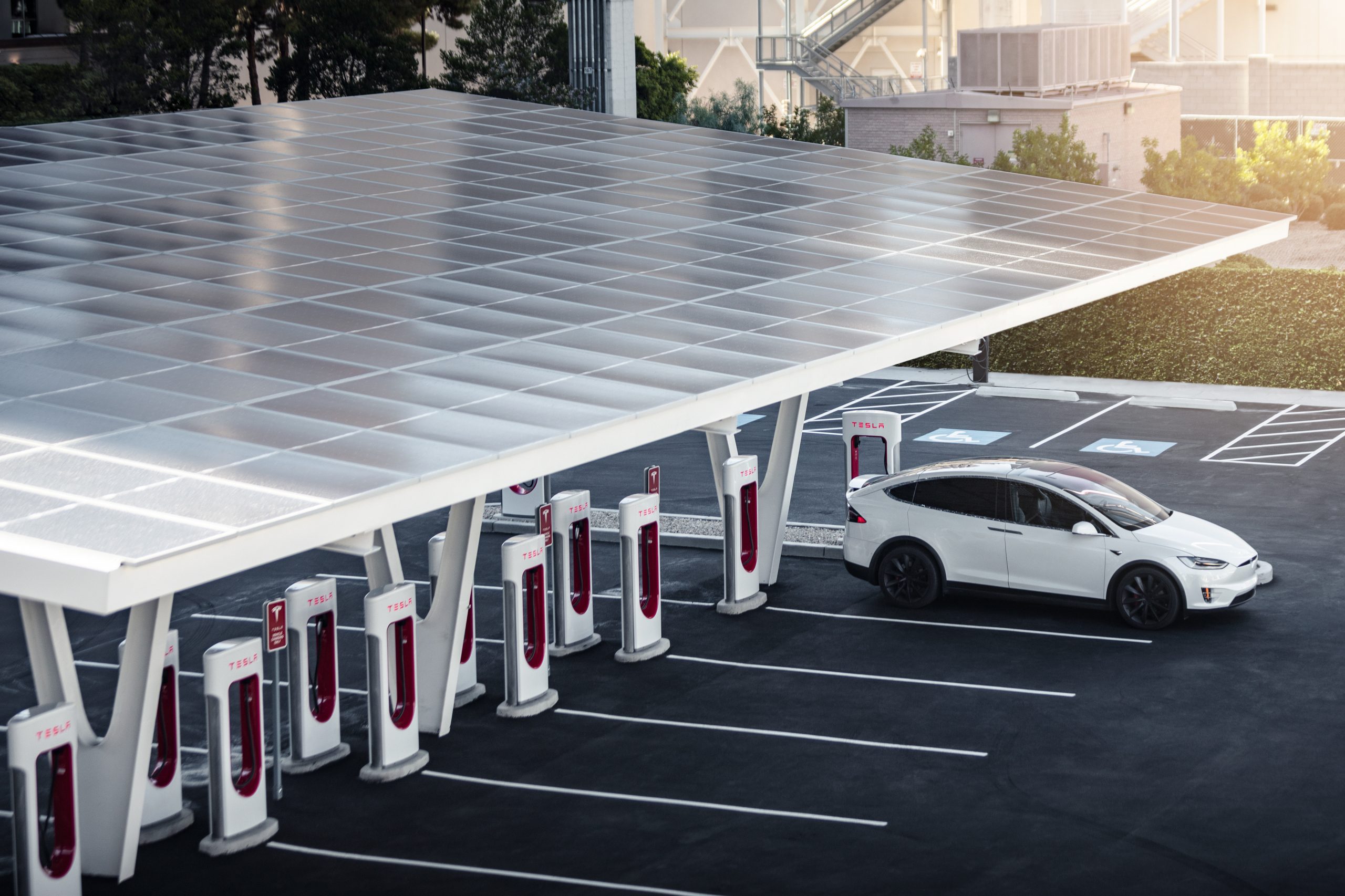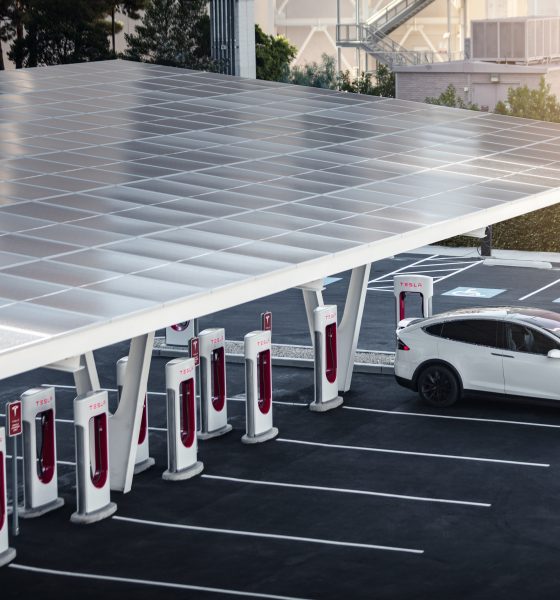Update: 11:21 a.m. E.T. 10/7: Tesla has removed all “Coming Soon” locations on its website. The leak has been neutralized.
Update: 11:54 a.m. E.T.: Updated hL and added detail to paragraph 4. Locations were leaked globally and not just in the U.S. and Canada.
Tesla has apparently leaked the locations of planned Supercharger projects across the world, as the company’s “Find Us” page on its website has been swarmed with locations that are “Coming Soon.”
Initially found by @MarcoRPTesla, who is widely considered one of the most reliable Supercharger project locators on Twitter, and @cyrus_ott, the United States Supercharger page, in fact, does have 347 locations that are listed as “Coming Soon.”
Additionally, Tesla’s Supercharger locator for Canada also has 59 locations that are listed as “Coming Soon.”
If anyone’s wondering what’s going on right now and why I’m so excited, it seems that Tesla has accidentally leaked addresses for virtually ALL future Superchargers in their Find Us lists (confirmed in the US and Canada). @SawyerMerritt @Tesla @elonmuskhttps://t.co/Q1swxs2RLG
— The Supercharger Whisperer (@MarcoRPTesla) October 6, 2022
Additionally, it appears the locations are also available in Australia and Europe.
And Australia. pic.twitter.com/oUJ76udkdU
— techAU (@techAU) October 6, 2022
Apparently the future addresses have been released for the US & Canada too. @MarcoRPTesla is tweeting about it and thinks the release may be a mistake. I’m sure he will get to the bottom of this. Follow him for supercharger news. ?????????? https://t.co/fVQLTGr0BE
— Tesla In The UK (@TeslaInTheUK) October 6, 2022
It is unclear if Tesla meant to do this or if this was an accidental leak. Nevertheless, be sure to check out some of the new locations that may be coming to your area. It appears my state of Pennsylvania will be receiving three new Supercharger projects, that is, if this lists all of the planned construction sites.
Tesla has been expanding its Supercharger infrastructure since ramping up production of its electric vehicles following the release of the Model S in 2012. While Tesla operates the majority of its 35,000+ Supercharger piles in the United States, the automaker has worked to make its infrastructure more available as it has more vehicles on the road.
Recently, Tesla celebrated opening its 10,000th Supercharger in the European market.
It would make sense for Tesla to reveal the locations of Supercharger projects that have been proposed and approved by local governments. It could help Tesla increase sales, especially if residents in an area do not have Supercharger within a reasonable distance. If Tesla reveals some of the locations to potential consumers, it may help drive consumers to purchase a Tesla over other electric vehicles.
Additionally, Tesla could launch a non-Tesla Supercharging pilot program in the United States this year, which could be another reason for the leak of all planned locations. Tesla’s company mission has always been to “Accelerate the Transition to Sustainable Energy.” Perhaps the skeptics of the EV transition, who are not convinced it is viable due to a lack of EV chargers in their area, could have their minds changed by the influx of Supercharger locations that Tesla is planning to build.
Of course, Tesla is not the only company building EV chargers. Third-party companies like Electrify America have partnerships with other brands and have been crucial in expanding the total market share of EVs in the United States, Canada, and other regions.
Tesla is also planning to let owners choose new Supercharger locations via a polling system, so revealing where the automaker already has plans to build chargers could expedite the voting process.
I’d love to hear from you! If you have any comments, concerns, or questions, please email me at joey@teslarati.com. You can also reach me on Twitter @KlenderJoey, or if you have news tips, you can email us at tips@teslarati.com.

Elon Musk
Elon Musk and Tesla AI Director share insights after empty driver seat Robotaxi rides
The executives’ unoccupied tests hint at the rapid progress of Tesla’s unsupervised Robotaxi efforts.

Tesla CEO Elon Musk and AI Director Ashok Elluswamy celebrated Christmas Eve by sharing personal experiences with Robotaxi vehicles that had no safety monitor or occupant in the driver’s seat. Musk described the system’s “perfect driving” around Austin, while Elluswamy posted video from the back seat, calling it “an amazing experience.”
The executives’ unoccupied tests hint at the rapid progress of Tesla’s unsupervised Robotaxi efforts.
Elon and Ashok’s firsthand Robotaxi insights
Prior to Musk and the Tesla AI Director’s posts, sightings of unmanned Teslas navigating public roads were widely shared on social media. One such vehicle was spotted in Austin, Texas, which Elon Musk acknowleged by stating that “Testing is underway with no occupants in the car.”
Based on his Christmas Eve post, Musk seemed to have tested an unmanned Tesla himself. “A Tesla with no safety monitor in the car and me sitting in the passenger seat took me all around Austin on Sunday with perfect driving,” Musk wrote in his post.
Elluswamy responded with a 2-minute video showing himself in the rear of an unmanned Tesla. The video featured the vehicle’s empty front seats, as well as its smooth handling through real-world traffic. He captioned his video with the words, “It’s an amazing experience!”
Towards Unsupervised operations
During an xAI Hackathon earlier this month, Elon Musk mentioned that Tesla owed be removing Safety Monitors from its Robotaxis in Austin in just three weeks. “Unsupervised is pretty much solved at this point. So there will be Tesla Robotaxis operating in Austin with no one in them. Not even anyone in the passenger seat in about three weeks,” he said. Musk echoed similar estimates at the 2025 Annual Shareholder Meeting and the Q3 2025 earnings call.
Considering the insights that were posted Musk and Elluswamy, it does appear that Tesla is working hard towards operating its Robotaxis with no safety monitors. This is quite impressive considering that the service was launched just earlier this year.
Elon Musk
Starlink passes 9 million active customers just weeks after hitting 8 million
The milestone highlights the accelerating growth of Starlink, which has now been adding over 20,000 new users per day.

SpaceX’s Starlink satellite internet service has continued its rapid global expansion, surpassing 9 million active customers just weeks after crossing the 8 million mark.
The milestone highlights the accelerating growth of Starlink, which has now been adding over 20,000 new users per day.
9 million customers
In a post on X, SpaceX stated that Starlink now serves over 9 million active users across 155 countries, territories, and markets. The company reached 8 million customers in early November, meaning it added roughly 1 million subscribers in under seven weeks, or about 21,275 new users on average per day.
“Starlink is connecting more than 9M active customers with high-speed internet across 155 countries, territories, and many other markets,” Starlink wrote in a post on its official X account. SpaceX President Gwynne Shotwell also celebrated the milestone on X. “A huge thank you to all of our customers and congrats to the Starlink team for such an incredible product,” she wrote.
That growth rate reflects both rising demand for broadband in underserved regions and Starlink’s expanding satellite constellation, which now includes more than 9,000 low-Earth-orbit satellites designed to deliver high-speed, low-latency internet worldwide.
Starlink’s momentum
Starlink’s momentum has been building up. SpaceX reported 4.6 million Starlink customers in December 2024, followed by 7 million by August 2025, and 8 million customers in November. Independent data also suggests Starlink usage is rising sharply, with Cloudflare reporting that global web traffic from Starlink users more than doubled in 2025, as noted in an Insider report.
Starlink’s momentum is increasingly tied to SpaceX’s broader financial outlook. Elon Musk has said the satellite network is “by far” the company’s largest revenue driver, and reports suggest SpaceX may be positioning itself for an initial public offering as soon as next year, with valuations estimated as high as $1.5 trillion. Musk has also suggested in the past that Starlink could have its own IPO in the future.
News
NVIDIA Director of Robotics: Tesla FSD v14 is the first AI to pass the “Physical Turing Test”
After testing FSD v14, Fan stated that his experience with FSD felt magical at first, but it soon started to feel like a routine.

NVIDIA Director of Robotics Jim Fan has praised Tesla’s Full Self-Driving (Supervised) v14 as the first AI to pass what he described as a “Physical Turing Test.”
After testing FSD v14, Fan stated that his experience with FSD felt magical at first, but it soon started to feel like a routine. And just like smartphones today, removing it now would “actively hurt.”
Jim Fan’s hands-on FSD v14 impressions
Fan, a leading researcher in embodied AI who is currently solving Physical AI at NVIDIA and spearheading the company’s Project GR00T initiative, noted that he actually was late to the Tesla game. He was, however, one of the first to try out FSD v14.
“I was very late to own a Tesla but among the earliest to try out FSD v14. It’s perhaps the first time I experience an AI that passes the Physical Turing Test: after a long day at work, you press a button, lay back, and couldn’t tell if a neural net or a human drove you home,” Fan wrote in a post on X.
Fan added: “Despite knowing exactly how robot learning works, I still find it magical watching the steering wheel turn by itself. First it feels surreal, next it becomes routine. Then, like the smartphone, taking it away actively hurts. This is how humanity gets rewired and glued to god-like technologies.”
The Physical Turing Test
The original Turing Test was conceived by Alan Turing in 1950, and it was aimed at determining if a machine could exhibit behavior that is equivalent to or indistinguishable from a human. By focusing on text-based conversations, the original Turing Test set a high bar for natural language processing and machine learning.
This test has been passed by today’s large language models. However, the capability to converse in a humanlike manner is a completely different challenge from performing real-world problem-solving or physical interactions. Thus, Fan introduced the Physical Turing Test, which challenges AI systems to demonstrate intelligence through physical actions.
Based on Fan’s comments, Tesla has demonstrated these intelligent physical actions with FSD v14. Elon Musk agreed with the NVIDIA executive, stating in a post on X that with FSD v14, “you can sense the sentience maturing.” Musk also praised Tesla AI, calling it the best “real-world AI” today.










